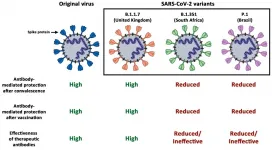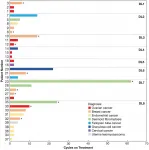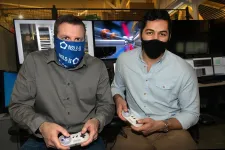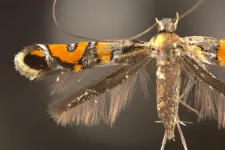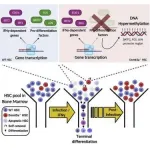(Press-News.org) While urban agriculture can play a role in supporting food supply chains for many major American cities -- contributing to food diversity, sustainability and localizing food systems -- it is unrealistic to expect rooftop gardens, community plots and the like to provide the majority of nutrition for the population of a metropolis.
That's the conclusion of a team of researchers who analyzed the nutritional needs of the population of Chicago and calculated how much food could be produced in the city by maximizing urban agriculture, and how much crop land would be needed adjacent to the city to grow the rest. The study was the first to evaluate land required to meet food demand while accounting for a range of nutritional needs instead of only calories or quantities.
"There is a tremendous enthusiasm around the country for localized food systems and urban agriculture," said lead researcher Christine Costello, assistant professor of agricultural and biological engineering, College of Agricultural Sciences, Penn State. "We wanted to determine how much nutrition urban agriculture really can contribute -- to find out what's feasible -- as well as how much land is required to meet the population's needs."
Now, with the COVID-19 pandemic exposing weaknesses in food supply chains, the focus on localizing food systems has sharpened, especially in and around big cities. Answering questions about how much food urban agriculture actually can contribute is more important than ever, Costello pointed out. For example, a recent study found that 30% of Boston's fruit and vegetable demand could be met in Boston through soil-based and rooftop urban agriculture.
With growing populations and affluence, urban food demand will increase, which presents considerable challenges to achieving economic, environmental and social sustainability, Costello noted. At the same time, more people are living in urban environments. In 2018 in the U.S., 82% of the population lived in urban areas, with an anticipated increase to 89% by 2050.
"Urban agriculture is attractive because it uses land or rooftops not currently used for food production and could increase habitat and biodiversity, enhance stormwater management, and provide fruits and vegetables, resulting in positive nutritional outcomes," Costello said. "However, fruits and vegetables do not contain sufficient calories, protein or other critical nutrients, such as vitamin B12, to support the full range of human needs."
Cultivation in soil on a rooftop typically is limited without significant restructuring of the roof, often making it infeasible, Costello explained. For this reason, hydroponic or vertical farming systems may be preferable. Hydroponic systems are best suited to produce leafy greens, such as kale and lettuce, and herbs.
In the study, researchers calculated the land required to meet the needs of Chicago and adjacent communities with and without urban agriculture food production, which they estimated two ways. One used average yields from urban and conventional farming methods; the other used optimization techniques to produce necessary nutrients using the smallest land base possible.
The team estimated the total nutrient requirements of Chicago's population using the daily food nutrient requirements recommended by the U.S. Department of Agriculture's Center for Nutrition Policy and Promotion. Twenty-eight nutrients were considered. Foods included in the study were selected based on their current prevalence in the American agricultural system and for their nutritional qualities.
The scientists estimated the amount of land required for each animal-based commodity using a formula based on USDA recommendations and prior research done by Costello. The researchers created linkages between crops and livestock in a model and used national inventory data to estimate both cropland and pastureland utilized for each kilogram -- about 2 pounds -- of animal food commodity.
The study used satellite data to define land-type availability and incorporated USDA data on yield for conventionally grown crops over a 10-year period. Soil-based urban agricultural yield data for the 2015 and 2016 growing seasons came from the Columbia Center for Urban Agriculture, located in Missouri.
The findings, recently published in Environmental Science and Technology, suggested that it is not possible -- using the predominant commodities and common urban agricultural production of today -- to meet the nutritional needs of Chicago within a radius under 400 miles, given the cropland and pastureland available, without fortifying foods with vitamin D and supplementing foods with vitamin B12.
With vitamin D fortification, a common U.S. practice, the radius required is reduced to 110-140 miles. With vitamin B12 supplementation, the radius was further reduced to 40-50 miles. The inclusion of urban agriculture reduced the radius by another 6-9 miles and increased the diversity of foods available.
"This work demonstrates the need to include a full list of nutrients when evaluating the feasibility of localizing food systems," Costello said. "Key nutrient fortification or supplementation may significantly reduce the land area required to meet the nutritional needs of a population."
INFORMATION:
Also involved in the research were Zeynab Oveysi and Ronald McGarvey, Department of Industrial and Manufacturing Systems Engineering, University of Missouri; and Bayram Dundar, formerly with the University of Missouri, currently at Bartin University in Turkey.
The University of Missouri's seed grant program, Mizzou Advantage, partially supported this work.
Scientists have shown that SARS-CoV-2, the virus that causes COVID-19, can infect specific cells in the salivary gland in the mouth. The study by researchers from the Wellcome Sanger Institute, National Institutes of Health and the University of North Carolina at Chapel Hill, and their collaborators within the Human Cell Atlas Oral & Craniofacial Network, also discovered that live cells from the mouth were found in saliva, and that the virus was able to reproduce within these infected cells.
The study revealed that salivary gland cells could play a role in transmission ...
Göttingen, March 25, 2021. Testing and vaccination - these are the pillars on which humanity is trying to get a grip on the Coronavirus pandemic. Although it is taking longer than many had expected, it is believed that it is only a matter of time before we are all vaccinated and thus protected. However, time is also working for the virus, which has now mutated several times, with variants B.1.1.7 from the United Kingdom, B.1.351 from South Africa and P.1 from Brazil spreading rapidly. These viruses have mutations in the so-called spike protein, the structure on the surface of the virus that is responsible for attachment to host cells. At the same time, the spike protein is also the major target of the immune response. Antibodies generated in response to SARS-CoV-2 infection or vaccination ...
Supersized alcopops are ready-to-drink flavored alcoholic beverages with high alcohol content that are disproportionately consumed by underage drinkers. There can be up to 5.5 standard alcoholic drinks in a single 24 ounce can, so consuming only one can of supersized alcopop is considered binge drinking, and consuming two cans can cause alcohol poisoning. Still, these products remain under-regulated and are available inexpensively at gas stations and convenience stores, where they are more readily accessible by underage youth.
New research led by George Mason University's College of Health and Human Services found that nearly ...
The burial field in Valsgärde outside Uppsala in central Sweden contains more than 90 graves from the Iron Age.
"On a light note, we could say that Valsgärde is Scandinavia's answer to Sutton Hoo in England as portrayed in the film The Dig on Netflix," says Birgitta Berglund, professor emeritus of archaeology at the Norwegian University of Science and Technology's NTNU University Museum.
Valsgärde is especially known for its spectacular boat graves from the 600s and 700s CE. This timeframe is in the middle of what Norway calls the Merovingian period, the era just before the Viking Age.
Two of these spectacular boat graves are at the centre of this story -- or more specifically, the story is really about the down bedding that was found ...
Oncotarget published "Phase 1 study of Z-Endoxifen in patients with advanced gynecologic, desmoid, and hormone receptor-positive solid tumors" which reported that Z-endoxifen administration was anticipated to bypass these variations, increasing active drug levels, and potentially benefiting patients responding sub-optimally to tamoxifen.
Patients with treatment-refractory gynecologic malignancies, desmoid tumors, or hormone receptor-positive solid tumors took oral Z-endoxifen daily with a 3 3 phase 1 dose escalation format over 8 dose levels.
Three patients had partial responses and 8 had prolonged stable disease; 44.4% of patients at dose levels 6–8 achieved one of these ...
UPTON, NY — Inspired by the mastery of artificial intelligence (AI) over games like Go and Super Mario, scientists at the National Synchrotron Light Source II (NSLS-II) trained an AI agent – an autonomous computational program that observes and acts – how to conduct research experiments at superhuman levels by using the same approach. The Brookhaven team published their findings in the journal Machine Learning: Science and Technology and implemented the AI agent as part of the research capabilities at NSLS-II.
As a U.S. Department of Energy (DOE) Office of Science User Facility located at DOE’s Brookhaven National Laboratory, NSLS-II enables scientific studies by more than 2000 researchers each year, ...
Akito Kawahara was snapping pictures at a scenic outlook in Hawaii when he spotted the moth equivalent of a dodo.
An entomologist, Kawahara recognized the squiggly patterns on nearby plants as trails carved by leaf-mining caterpillars and lowered his camera to take a closer look. To his astonishment, he saw a tiny moth most experts assumed was extinct. It belonged to a genus known as Philodoria, a type of moth found only in Hawaii and one that hadn’t been documented in the wild since 1976.
“I thought, ‘Oh my God, there’s a Philodoria ...
New research shows that consumers judge 'activist brands' based on how morally competent they are perceived to be when challenging free speech.
The report, co-authored by experts at the Business School (formerly Cass), Birkbeck, University of London and the University of Sussex Business School explains that stakeholders draw their conclusions on the biggest brands by measuring three moral skills: sensitivity, vision, and integration.
Lacking these traits, a brand raising controversy is judged as transgressing, reproducing and manipulating the boundaries of free speech. Displaying these traits proves the brand is not merely 'woke-washing' ...
HOUSTON, TX - March 25, 2021 - Humans are born with tens of thousands of hematopoietic stem cells (HSCs) that collectively ensure lifelong production of blood and immune cells that protect us from infections. HSCs can either duplicate to produce more stem cell progeny or differentiate to produce distinct immune cell lineages, an extremely critical decision that ensures that the body achieves the fine balance between having enough immune cells to fight invaders while still retaining enough HSCs to maintain future blood production. As we age, HSCs accumulate mutations that lead to the ...
More than 150 years ago, the Sun blasted Earth with a massive cloud of hot charged particles. This plasma blob generated a magnetic storm on Earth that caused sparks to leap out of telegraph equipment and even started a few fires. Now called the Carrington Event, after one of the astronomers who observed it, a magnetic storm like this could happen again anytime, only now it would affect more than telegraphs: It could damage or cause outages in wireless phone networks, GPS systems, electrical grids powering life-saving medical equipment and more.
Sun-facing satellites monitor the Sun's ultraviolet (UV) light to give us advance warning of solar storms, both big ones that could cause a Carrington-like ...

